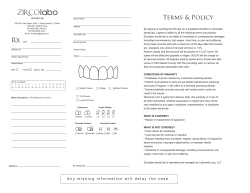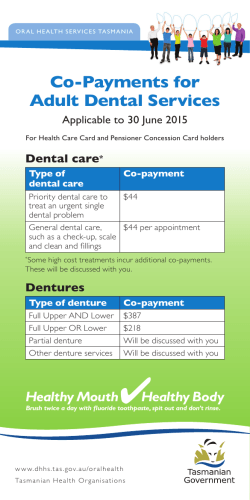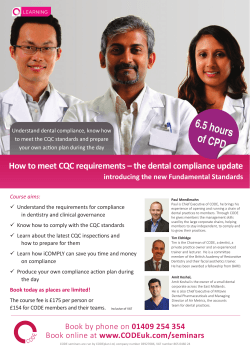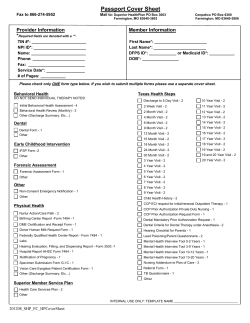
restorative treatment under ga in children below six years of age in
Pedodontics Original Article RESTORATIVE TREATMENT UNDER GA IN CHILDREN BELOW SIX YEARS OF AGE IN PIMS, PAKISTAN — A STUDY 1 SAEEDA ABDULLAH, BDS, MCPS, FCPS ABSTRACT Dental treatment under GA is indicated for mentally or physically retarded patients and also for fearful young children. The objectives of the present study were to find out ratio of healthy and handicapped children treated under GA, reasons for performing dental procedures under GA in healthy children and also to find out what type of restorative dental treatment was given in Children’s Hospital (PIMS, SZABSU), Islamabad. This was a cross-sectional, retrospective study on 84 patients, who were treated for only restorative dental procedures under GA during 2013. Data were collected from hospital records of Dental Department of Children’s Hospital (PIMS). Information such as the reason for giving GA, and the type of treatment provided were recorded in data sheet. The data were analyzed using SPSS 20. Total 84 cases were treated for restorative work under GA, out of which 17 (20%) were mentally retarded, while 67 (80%) were healthy children. All healthy children treated under GA because they were very un-coperative. Out of total 84 patients, 63(75%) were males and 21(25%) were females and the difference is statistically highly significant (P<0.01). Maximum patients treated were in age group of 5 years and this difference with other age groups is significant (P<0.05). Maximum patients treated were during month of July. Treatment pattern in deciduous dentition revealed more restorations (N=391) than extractions. Total 33 pulpotomies, 08 fissure sealants in primary teeth, and 47 fissure sealants in permanent teeth were placed. Fear of dental treatment was the main reasons for treatment of healthy children. Restoration and extractions were the most frequently performed procedures under GA. Key Words: Dental treatment under GA, Behaviour management of paediatric patients, Dental treatment of handicapped children. INTRODUCTION Behavioral management plays an important role in pediatric dentistry, particularly when treating younger patients. Most young children readily accept dental treatment with the aid of behavior management, but some children fail to respond due to a lack of psychological maturity, and mental/ physical or medical disabilities.1,2 These patients require general anesthesia (GA) for dental treatment. The purpose of GA in dental treatment is to allow total oral rehabilitation, which consists of restorations, pulpal treatment, extraction, and/or stainless steel crown reconstruction, in a single session.3 The American Academy of Pediatric Dentistry (AAPD) has stated indications for GA in children and adolescents as follows: (a) patients who cannot cooperate due to a lack of psychological or emotional Assistant Professor Operative Dentistry, Dental Department, Pakistan Institute of Medical & Health Sciences, Islamabad Received for Publication: October 18, 2014 Revision Received: November 10, 2014 Revision Accepted: November 25, 2014 1 Pakistan Oral & Dental Journal Vol 34, No. 4 (December 2014) maturity and/or mental, physical, or medical disability, (b) patients for whom local anaesthesia is ineffective because of acute infection, anatomical variations, or allergy, (c) patients who are extremely uncooperative, fearful, anxious, or uncommunicative, (d) patients who require significant surgical procedures or immediate, comprehensive oral/dental care and (e) patients for whom the use of GA may protect the developing psyche and/or reduce the medical risk.4 The AAPD and the Special Care Dentistry Association (SCDA) both emphasize that dentists should consider other techniques as alternatives to GA and should use preventive care in order to find best treatment modality and achieve good results in the long term.4-6 General anaesthesia should not be used as a method of anxiety control but for pain control, because more specific methods (local anaesthesia with or without conscious sedation and behaviour management techniques) are available to manage anxiety.7 All general anaesthetics are associated with some risk and GA should be strictly limited to those patients and clinical situations in which local anaesthesia (with or without sedation) is not an option.8 665 Restorative treatment under GA in children GA is utilized for pediatric dental patients to provide comprehensive and high quality dental care when conventional dental treatment is impossible. It is an efficient treatment modality, since full-mouth rehabilitation can be performed during a single appointment, and it requires little or no cooperation from the patient. Nevertheless, GA is considered only as the last option, because it may pose risk for the patient’s overall health.9-10 Reports indicate that in the western world, the demand for treatment under GA in children has been growing.11,12 Children are being referred to dental treatment under GA for various reasons including very young age of a child, fear of a dentist, uncooperative behavior, complex medical/physical/ mental conditions, a need for extensive treatment (e.g., surgical procedures), and others. The child’s parents greatly appreciate GA as a treatment modality13, as it significantly improves the oral health-related quality of life of young children and has a positive impact on their families.14,15 Restorative procedures and simple extractions are the most frequent types of treatment modalities. There has been a trend toward fewer restorations and pulpotomies, but more extractions, stainless steel crowns, and more fissure sealants placed during comprehensive dental care under general anesthesia.10 Studies have shown that the quality of restorations carried out under GA is considerably better than under local anesthesia due to more effective moisture control and more accurate placement of planned restorations.16 However, treatment under GA is a costly method of delivering dental care, and access to it is often limited due to long waiting periods in most hospitals as well as travel costs.9,10 Some parents may find it hard to accept dental treatment for their children under GA. Current approaches to general anesthesia can provide total relaxation of the patient, allowing for successful treatment of even the most phobic dental patient.4 GA does not diminish dental fear5, but the aim in using GA is to restore the child’s oral health at a single visit allowing behavior modification methods to be introduced more readily afterwards. The American Academy of Paediatric Dentistry encourage dentists to consider other technique as alternatives to GA and use preventive care in order to find best treatment modality and achieve good results in the long term.4 METHODOLOGY This was a cross-sectional and retrospective study in which data were retrieved from the hospital records of dental department of Childrens Hospital (PIMS), Shaheed Zulfiqar Ali Bhutto University, Islamabad. Childrens Hospital (PIMS) is tertiary care centre for children of less than 13 years old. Patients between 2-6 years of age, who received restorative dental treatments under GA from January to December 2013 were included in the present study. Patients required GA for impression taking (like for cleft lip and palate cases), those who required biopsy or any surgery with or without restorative procedure were excluded from the present study. Data collection All the patients received dental and anesthetic pre-operative assessments. Dental assessment included a dental and medical history, clinical examination, oral radiographs and appropriate hematological tests. A provisional treatment plan for each patient was formulated and advice on prevention was given to the parents. A consultant anesthesiologist made an assessment of the patient’s suitability for general anesthesia and commented on any precautions to be taken. On the day of the operation, the treatment plan was finalized and consent was obtained. Most dental treatments were carried out under general anesthesia with naso-endotracheal intubation. All dental treatments were performed by one of senior dentists. Unless there were other adverse conditions, the patient was discharged one hour after recovery. The data from their personal profiles were retrospectively reviewed, including general history, dental history, reasons for general anesthesia and treatment modalities, such as the number of restorative primary teeth, sealant procedures, the number of pulp treated primary teeth and extracted primary teeth were recorded in data sheet. Total 84 patients fulfilled inclusion criteria. Statistical analyses The data were recorded and analyzed using a two-sample t-test, with p < 0.05 indicating significance using the SPSS 20 (IBM, Chicago, U.S.A.) program. The Objectives of present study were to: RESULTS 1 The data were analyzed using SPSS 20. Total OPD of dental department of children’s hospital was 9,773 from1st January 31 to December 2013. Patients treated under GA for only restorative work were 84 (0.85%). Out of total of 84 cases treated, 17 (20%) were mentally retarded, while 67 (80%) were healthy children (Fig 1). Patients were mostly diagnosed to have Find out percentage of healthy and mentally retarded children received dental treatment under GA and most common reason for using GA in healthy patients for restorative procedure. 2 Find out the type of dental treatment provided under GA in Children Hospital, PIMS, (SZABMU) Islamabad. Pakistan Oral & Dental Journal Vol 34, No. 4 (December 2014) 666 Restorative treatment under GA in children TABLE 1: TREATMENT PROVIDED ACCORDING TO AGE AND GENDER Age in Sex years 2 3 4 5 6 Total filled Total Extractions Total Pulpotomies Total FS in Primary teeth Total FS in Permanent teeth Male 12 0 2 4 0 Female 5 3 0 2 0 Male 75 38 7 0 0 Female 31 26 0 0 0 Male 63 45 0 1 0 Female 20 14 0 0 0 Male 96 98 12 0 0 Female 33 40 1 0 2 Male 39 41 9 1 38 Female 17 25 2 0 7 Total 391 330 33 8 47 TABLE 2: PERCENTAGES OF MATERIALS USED FOR RESTORATION UNDER GA Restorations N (%) Amalgam 35 (9%) Glass Ionomer 238 (61%) Composite 118 (30%) TABLE 3: AGE WISE DISTRIBUTION OF GENDER Age in years Total 2 3 4 5 6 Male 2 15 15 20* 11 63** Female 1 5 4 6 5 21 Total 3 20 19 26* 16 84 *P<0.05 **P<0.01 Fig 2: Gender distribution rampant caries (77%) and all healthy children treated under GA due to their very un-cooperative behaviour. Treatment pattern in deciduous dentition revealed more restorations (N=391) than extractions (N=330) or pulpotomies (N=33) (Table 1). Treatment pattern in deciduous dentition revealed more restorations (N=391) than extractions. 33 pulpotomies, 08 fissure sealants in primary teeth, and 47 fissure sealants in permanent teeth were placed. (Table 1) The percentages of restoring carious teeth were higher than that of pulpotomies in the primary teeth. Majority of the restorations were done using Glass Ionomer cements (61%), while composited were used in 30 % and amalgam in 9 % of cases (Table 2). Fig 1: Ratio of Healthy & Handicapped Children Pakistan Oral & Dental Journal Vol 34, No. 4 (December 2014) The age of the patients ranged from 2 to 6 years. Male patients 63(75%) were more than female 21(25%) and the difference is highly significant (P<0.01) (Fig 2). Maximum patients treated were in age group of 5 667 Restorative treatment under GA in children years and difference with other age groups is significant (P<0.05) (Table 3). Maximum patients treated were during the month of July (Fig 3). DISCUSSION Dental treatment performed under general anesthesia in a hospital environment provides great efficacy and safety for particular groups of patients, such as very young or disabled children.17 In present study, healthy children were 65 (80%) and mentally retarded children who received dental treatment were only 17 (20%). Therefore in present study, fear of dental treatment was the main reason for seeking treatment under general anesthesia by healthy children, which is consistent with another study.13 In present study, the percentage of healthy children who received dental treatment under GA due to fear is higher than that reported by Tsai18 (69.9%), O’Sullivan and Curzon19 (76%) Wong17 (40%), Tarján20 (49%), Karim21 and Birute22 (52.1%). Similarly Ibricevic23 also reported the anxiety and fear to dental procedures were main reasons for undergoing GA for restorative work, while Xia B24 found uncooperativeness and disability of children was the main reasons of dental treatment under GA. As extreme dental fear was the most important factor leading to GA, therefore be taken into account and prevented early on in order to reduce the need for GA. Dental fear needs to be dealt with after GA because GA does not diminish dental fear.5 The majority of the patients (31%) were in age group of 5 years in present study. In this age group, the greatest difficulty was fear of dental treatment problems combined with severe early childhood caries. The ratio of male to female was 3:1 in present study, which shows male patients, were more apprehensive and less cooperative. The reason for this high ratio of males may be due to fact that males are getting more attention and more pampered as compared to females in this society, therefore they are more spoiled and show behavior problems. Similarly, high ratios of male to females patients were reported by Al-Eheideb25 (1.7:1) and Tsai18 (1.2:1), but the ratio in present study was quiet higher than these studies. Ibricevic23 showed significantly higher number of dental procedures for healthy patients in his study23. In present study (80%) were healthy children, therefore more dental procedures were done in healthy patients as compared to disabled patients. Bohaty26 reported a trend toward fewer restorations and pulpotomies, but more extractions, stainless steel Pakistan Oral & Dental Journal Vol 34, No. 4 (December 2014) crowns, and more fissure sealants.26 Present study showed more restorations and extractions and few endodontics or fissure sealants. The reason for less endodontics and fissure sealants may be due to less awareness of parents about oral disease or importance of primary dentition; therefore they bring their children only when dental problem interfere their normal activities. In majority of cases by that time saving of tooth is not possible and extraction is the only treatment left. In present study, majority of deciduous teeth were extracted as compared to the permanent dentition like reported by Karim21 and Varpio.27 The reason for more primary teeth extractions in present study was young age of the patients. Only 16 (19%) of the patients were in early mixed dentition while rest were with primary dentition stage (Table 1), therefore more primary teeth were available for extractions. Glass Ionomer Cements (GIC) was the most commonly used restorative material in present study due to its advantages as a tooth colored material, adhere to tooth through an ion exchange mechanism. GIC is also biologically active material, because it is capable of releasing fluoride, calcium and phosphate ions. Jamjoom28 and Xia24 also reported more GIC restorations in their studies while Vinkier29 reported more amalgam restorations. General anaesthesia for a healthy, fearful child is extremely safe and, in the long run, is the best outcome for the profession and patient30. Even if dental care under general anaesthesia is a very effective treatment modality, it is often the last resort because of the expense and risk-benefit considerations 13 and also some parents may find it hard to accept.31 CONCLUSION Fear of dental treatment (very un-cooperative behaviour of the child) was the main reason for treatment of healthy children under GA and emphasis should be made on using behaviour modification methods to reduce it. Caries restoration and extractions were the most frequently performed procedures in paediatric patients using GA. This indicates the need to design and implement integrate control and prevention programs for special paediatric patients. Acknowledgment Help provided by Dr Zahida Ahmad (Senior Dental Surgeon) of PIMS for data collection in this study is appreciated. 668 Restorative treatment under GA in children REFERENCES 1 2 Lee P Y, Chou MY, Chen YL, Chen LP, Wang CJ, Huang WH. Comprehensive Dental Treatment under General Anesthesia in Healthy and Disabled Children. Chang Gung Med J 2009; 32 (6): 636-42. Tsai CL, Tsai YL, Lin YT, Lin YT.A Retrospective Study of Dental Treatment under General Anesthesia of Children with or without A Chronic Illness and/or A Disability. Chang Gung Med J 2006; 29: 412-18. 3 Academy of Pediatric Dentistry Council on Clinical Affairs-Guideline on behavior guidance for the pediatric dental patient. Pediatr Dent 2005-2006; 27: 92-100. 4 The American Academy of Pediatric Dentistry: Guideline on behavior guidance for the pediatric dental patient. 2011. 5 Savanheimo Nora, Sari A Sundberg, Jorma, Virtanen and Miira M . Dental care and treatments provided under general anaesthesia in the Helsinki Public Dental Service. Oral Health 2012; 12:45. 6 Glassman P, Caputo A, Dougherty N, Lyons R, Messieha Z, Miller C, Peltier B, Romer M. Special Care Dentistry Association consensus statement on sedation, anesthesia and alternative techniques for people with special needs. Spec Care Dentist 2009; 29:2–8. 16 Tate AR, Ng MW, Needleman HL, Acs G. Failure rates of restorative procedures following dental rehabilitation under general anesthesia. Pediatr Dent 2002; 24:69-71. 17 Wong FS, Fearne JM, Brook AH. Planning future general anaesthetic services in paediatric dentistry on the basis of evidence: an analysis of children treated in the Day Stay Centre at the Royal Hospitals NHS Trust, London, between 1985-95. Int Dent J 1997; 47:285-92. 18 Tsai CL, Tsai YL, Lin YT, Lin YT. A retrospective study of dental treatment under general anesthesia of children with or without a chronic illness and/or a disability. Chang Gung Med J 2006;29:412-18. 19 O’Sullivan EA, Curzon ME. The efficacy of comprehensive dental care for children under general anesthesia. Br Dent J 1991; 171:56-8. 20 Tarján I, Mikecz G, Denes J. General anaesthesia of outpatients in pedodontics. J Int Assoc Dent Child 1990;20:59-61. 21 Karim Z A, Musa N, Noor S N F.Utilization of dental general anaesthesia for Children. Malaysian Journal of Medical Sciences July 2008;(15)3:31-9. 22 Birute Jankauskiene, Jorma I. Virtanen, Ricardas Kubilius, Julija Narbutaite. Treatment Under Dental General Anesthesia Among Children Younger than 6 Years in Lithuania. Medicina (Kaunas) 2013;49(9):403-08. 7 Vinckier F, Gizani S, Declerck D. Comprehensive dental care for children with rampant caries under general anaesthesia. Int J Paed Dentistry 2001; 11: 25-32. 8 Stanford J. General anaesthesia for dentistry. Anaesth Int Care Med 2008; 9: 344-47. 9 Stratmann G. Neurotoxicity of anesthetic drugs in the developing brain. Anesth Analg 2011; 113:1170-179. 24 Xia B, Qin M, Ma WL, Lin H, Wang JH, Liu KY, Liu RC, Yang XD, Ge LH. A retrospective study of 693 children's dental treatment under general anesthesia. Beijing Da Xue Xue Bao. 2013 Dec 18; 45(6):984-88. 10 DiMaggio Ch, Sun LS, Li G. Early childhood exposure to anesthesia and risk of developmental and behavioural disorders in a sibling birth cohort. Anesth Analg. 2011; 113: 1143-151. 25 Al-Eheideb AA, Herman NG. Outcomes of dental procedures performed on children under general anesthesia. J Clin Pediatr Dent 2003;27:181-83. 11 Hicks CG, Jones JE, Saxen MA, Maupome G, Sanders BJ, Walker LA, et al. Demand in pediatric dentistry for sedation and general anesthesia by dentist anesthesiologists: a survey of directors of dentist anesthesiologist and pediatric dentistry residencies. Anesth Prog 2012; 59:3-11. 26 Bohaty B, Spencer P. Trends in dental treatment rendered under general anesthesia, 1978 to 1990. J Clin Pediatr Dent 1992; 16:222-24. 12 Madan C, Kruger E, Perera I, Tennant M. Trends in demand for general anaesthetic care for paediatric caries in Western Australia: geographic and socio-economic modeling of service utilisation. Int Dent J 2010; 60:190-96. 13 Savanheimo N, Vehkalahti MM, Pihakari A, Numminen M. Reasons for and parental satisfaction with children’s dental care under general anaesthesia. Int J Paediatr Dent 2005;15: 448-54. 14 Gaynor WN, Thomson WM. Changes in young children’s OHRQoL after dental treatment under general anaesthesia. Int J Paediatr Dent 2012; 22:258-64. 15 Thomson WM, Malden PE. Assessing change in the family impact of caries in young children after treatment under general anaesthesia. Acta Odontol Scand 2011; 69:257-62. Pakistan Oral & Dental Journal Vol 34, No. 4 (December 2014) 23 Ibricevic H, Al-Jame Q, Honkala S. Pediatric dental procedures under general anesthesia at the Amiri Hospital in Kuwait. J Clin Pediatr Dent 2001; 25: 337-42. 27 Varpio M, Wellfelt B. Some characteristics of children with dental behavior problems. Five-year follow-up of pedodontic treatment. Swed Dent J 1991; 15: 85-93. 28 Jamjoom MM, Al-Malik MI, Holt RD, El-Nassry. Dental treatment under general anaesthesia at a hospital in Jeddah, Saudi Arabia. Int J Paed Dent 2001; 11: 110-16. 29 Vinckier F, Gizani S, Declerck D. Comprehensive dental care for children with rampant caries under general anaesthesia. Int J Paed Dent 2001; 11: 23-32. 30 Wilson S. Pharmacological management of the paediatric dental patient. Pediatr Dent 2004; 26: 131-36. 31 Acs G, Pretzer S, Foley M, Ng MW. Perceived outcomes and parental satisfaction following dental rehabilitation under general anesthesia. Pediatr Dent 2001; 23: 419-23. 669
© Copyright 2026









